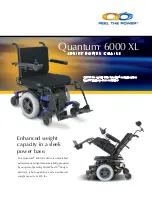
Comfort-Tilt
7
1.4
Position of Wheelchair
“Danger of Falling” WARNING
After a patient is transferred into a wheelchair, assess the amount of tilt required. We recommend
that the wheelchair
’s seat be tilted sufficiently to prevent the patient from sliding or falling forward
off the wheelchair. The amount of seat tilt used should be determined b
y the patient’s caregiver
who is responsible for seating.
We recommend that the patient’s feet be correctly positioned on the footrests to prevent the
patient from sliding or falling forward off the wheelchair. The amount of elevation used should be
determined
by the patient’s caregiver who is responsible for seating.
1.5
Position of Seat Tilt
“Danger of Tipping” WARNING
In an attempt to prevent agitated patients from falling out of the wheelchair or tipping the
wheelchair forward, the caregiver may decide to tilt the wheelchair. The amount of seat tilt used
should be determined by the patie
nt’s caregiver who is responsible for seating. Always ensure the
patient is properly positioned in the chair before tilting.
Before operating the seat tilt, carefully read through section 1.8
Repositioning of Patient “Danger
of Pinching.”
1.6
Wheelchair Placement
“Danger of Tipping” WARNING
We recommend that when a patient has been moved to their destination, the wheelchair is placed
so the patient cannot reach handrails or other objects, fixed or moveable. This is to prevent the
patient from pulling the wheelchair over or pulling themselves off the seating surface, and to
prevent the patients from pulling moveable objects onto the wheelchair and on themselves.
We recommend that the wheelchair be used in a supervised area to prevent untrained patients,
caregivers, or third parties from unauthorized operation, movement, or unsafe actions such as
sitting, standing or leaning on the reclined back, footrest, or the armrests. Individuals should not
stand on the seat. These actions, if not prevented, could put the wheelchair at risk of tipping or
may damage the wheelchair.
The seat depth, back height, size and position of the wheels, use of the anti-tippers, as well as
custom dimensions or changes relate directly to the stability of the chair. Any adjustments to the
above items must only be recommended or performed by an individual qualified to do so.
We recommend that a wheelchair only be used on a level surface to minimize the risk of tipping
over.
All Broda Comfort Tilt
’s are equipped with anti-tippers which are removable and adjustable.
However, they should remain attached to the chair and pointed downward at all times. The anti-
tippers can be pointed upward if necessary for traveling over a curb or such, however they must
be returned to the standard downward position for standard traveling and when the chair is in a
stationary position.
1.7
Locking Wheels
“Danger of Falling” WARNING
The wheel locks must always be applied when:
•
The wheelchair is not in use.
•
A patient is being transferred (moved) into or out of the wheelchair.
•
The patient in the wheelchair is not being moved by a caregiver.








































